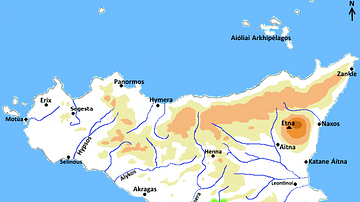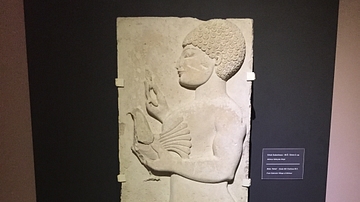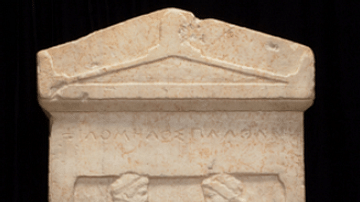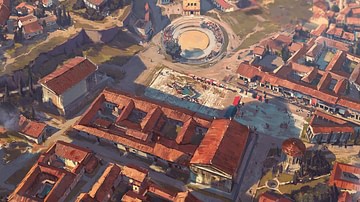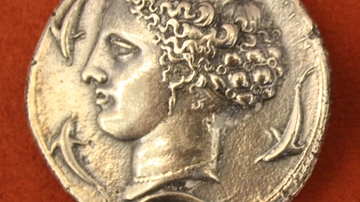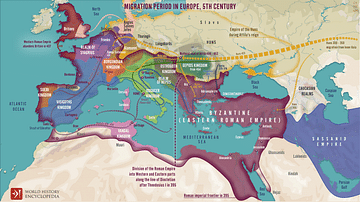Illustration
An illustration of the so-called Demaretéion is a silver coin of ancient Syracuse (weighing around 43 g) rather rare and worth 10 drachmas. It is also known as a pentekontalitron because it was equivalent to 50 litrae (the litra was a silver Sicels coin weighing about 0.87 g). Until recently it was believed that it was the famous coin ordered by Demarete (wife of the tyrant Gelon) after the Syracusan victory of Himera (480 BCE). The coin's obverse shows a charioteer driving a walking quadriga to the right: he holds a kentron (goad) in his left hand and the reins in his right. A "Nike" is flying above to crown the horses. In the exergue, a lion is running to the right. The back of the coin shows a female head turned towards the right. It has a crown of laurel leaves and her hair is gathered behind by a ribbon. Four dolphins are swimming clockwise around. The ethnic name, ΣΥ - RA - KΟΣ - ΙΟΝ (SYRAKOSION), in the plural genitive case, is written anti-clockwise and interspersed with dolphins.
Recent studies hypothesized that this decadramm is not the one mentioned by Diodorus Siculus (XI, 26.3), but it would have been coined to celebrate the fall of the Dinomenides, around 461 BCE (see, C.M. Kraay 1976, Archaic and Classical Greek Coins, London). This thesis, among other things, is supported by a tetradrachm publication coined in Aitna, which on the obverse presents a very similar quadriga to that of the so-called Demaretéion (see, C. BOEHRINGER 1968, Hieron's Aitna und das Hieroneion, in "Jahrbuch für Numismatik undGeldgeschichte", 18) and whose first issue can not be earlier than 476 BCE, when the tyrant Hieron re-founded Katàne (Catania) with the name of Áitna.
The Syracusan coin seems stylistically more recent than the tetradrachm of Áitna, and therefore could be called Hieronèion, that is a coin minted by Hieron around 470 BCE to propagate his government. Furthermore, there are epigraphic features that strengthen these hypotheses: the so-called Demaretéion is certainly dated to beyond 478 BCE, because in that year there was an epigraphic reform that led to the replacement of the qoppa (Ϙ) with the kay (K) on the inscriptions and on the coinage legends. The legend Σ Υ R A K Ο Σ Ι Ο Ν (syrakosion) of the so-called Demaretéion already shows up with the letter kay.
It is therefore highly likely that this decadrachm dates back to approximately the mid-70s of the 5th century BCE. Dies by the "Demaretéion Master" (the engraver's actual name is unknown) on other city coins created with similar features (the tetradrachm of Leontini).
Of the so-called Demaretéion there are known three anvil coinage (observe) and five hammer coinage (reverse) examples for a total of seven coinage combinations. The coin shown at the top, weighing 43.39 g, belongs to a third coinage type. Intotal only 17 samples are known and conserved in different parts of the world.
(Pencil drawing by Gina Pardo)
Cite This Work
APA Style
Pardo, G. (2018, April 12). 5th Century BCE Demareteion Coin. World History Encyclopedia. Retrieved from https://www.worldhistory.org/image/8610/5th-century-bce-demareteion-coin/
Chicago Style
Pardo, Gina. "5th Century BCE Demareteion Coin." World History Encyclopedia. Last modified April 12, 2018. https://www.worldhistory.org/image/8610/5th-century-bce-demareteion-coin/.
MLA Style
Pardo, Gina. "5th Century BCE Demareteion Coin." World History Encyclopedia. World History Encyclopedia, 12 Apr 2018, https://www.worldhistory.org/image/8610/5th-century-bce-demareteion-coin/. Web. 17 Apr 2025.

